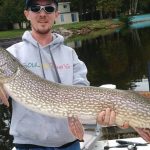Secretary of the Interior Ken Salazar announced a draft vision plan to guide the growth and management of the National Wildlife Refuge System. The draft document, developed by the U.S. Fish and Wildlife Service and National Wildlife Refuge Association, articulates a 10-year vision for the Refuge System.
The vision document, entitled Conserving the Future: Wildlife Refuges and the Next Generation, offers nearly 100 draft recommendations to protect and improve the world’s premier system of public lands and water set aside to conserve America’s fish, wildlife and plants for the continuing benefit of the American people. Starting today, the draft document will be available for public comment until Earth Day, April 22, 2011.
The Conserving the Future process comes on the heels of President Obama’s America’s Great Outdoors initiative to develop a conservation and outdoor recreation agenda for the 21st century. The process to develop a new vision for the Refuge System goes hand-in-hand with many of the priorities identified through the America’s Great Outdoors national dialogue, including greater access to recreation and connecting a new generation of conservationists to the outdoors.
“The National Wildlife Refuge System is one of the crown jewels of our conservation efforts and we must ensure that the System has the tools and vision to meet the challenges of tomorrow,” Salazar said. “I encourage all Americans to participate in the Conserving the Future process and to voice their bold ideas about the future priorities and management of our national wildlife refuges.”
There are 553 national wildlife refuges with at least one in every state and U.S. territory. Spanning more than 150 million acres of land and water, the Refuge System conserves wildlife habitat for hundreds of animal and plant species and includes more than 20 million acres of designated wilderness. The last time a vision statement was articulated for the System was 1999.
Among the draft vision’s recommendations are:
- To engage youth in an array of work and volunteer programs;
- To review the Appropriate Use Policy, so a wider variety of nature-based experiences may be possible;
- Within the next 10 years, to increase the number of minorities and people with disabilities who work for the Refuge System, in part by reaching high school and college youth from diverse communities and exposing them to Service conservation careers.
- To develop a five-year plan to “green” the Refuge System;
- To encourage a ‘Friends’ group for every staffed refuge; there are now about 230 Friends groups;
- To develop standards for credibility, efficiency and consistent application of science in planning and management;
- Working with state fish and wildlife agencies, to prepare a strategy to double youth participation in hunting and fishing by 2020, paying special attention to individuals of all ages with disabilities.
A website, http://americaswildlife.org, has been created to gather comments and ideas. A refined vision document reflecting the comments and ideas received online is expected to be published in July 2011.
“The use of new technologies and social media for this process invites the American people to contribute their bold ideas to set a new direction for the Refuge System,” said Rowan Gould, Acting Director of the Fish and Wildlife Service. “The time to engage is now. Join the conversation online through the website.”
For more information on Conserving the Future: Wildlife Refuges and the Next Generation, please visit the website at http://americaswildlife.org. Learn more about the National Wildlife Refuge System at http://www.fws.gov/refuges.
The mission of the U.S. Fish and Wildlife Service is working with others to conserve, protect and enhance fish, wildlife, plants and their habitats for the continuing benefit of the American people. We are both a leader and trusted partner in fish and wildlife conservation, known for our scientific excellence, stewardship of lands and natural resources, dedicated professionals and commitment to public service. For more information on our work and the people who make it happen, visit www.fws.gov.













